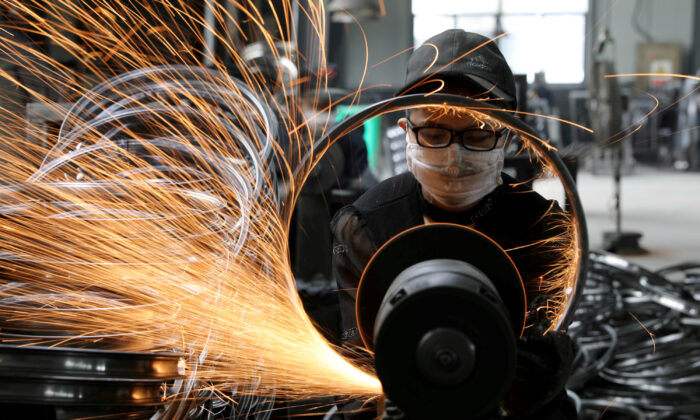BEIJING鈥擜ctivity in China’s vast manufacturing sector likely shrank at the fastest pace since the global financial crisis in February as the coronavirus suspended large movements of goods and people in most parts of the country.
China’s official manufacturing Purchasing Manager’s Index (PMI) is forecast to fall sharply to 46鈥攁 level not seen since January 2009鈥攆rom 50 a month earlier, according to the median forecast of 25 economists polled by Reuters. The neutral 50-point mark separates monthly growth from contraction.
The gloomy readings highlight the colossal economic damage to the world’s second-largest economy from the coronavirus that has forced draconian travel restrictions and quarantine rules.
Nomura expects first-quarter growth to be at 2.0 percent year-on-year while Capital Economics estimates China’s economy would contract outright in year-on-year terms this quarter, for the first time since at least the 1990s.
Wary of the deepening economic costs, the country’s top leaders have urged local governments, factories and workers to re-start operations as soon as possible in less affected regions, but many officials are concerned about a resurgence of infections.
Official data showed that production levels at China’s small and medium-sized companies, a major employment sector, were just 32.8 percent by Feb. 26, while a majority of migrant workers鈥攊ncluding those in Hubei鈥攁re yet to resume work.
Nomura estimated that only around 30-40 percent of migrant workers have returned and expected the lockdown in Hubei to be extended into mid-March. Hubei has over 10 million migrant workers.
Many small factory owners have struggled with labor shortages.
“We are not able to find people. Most of the migrant workers at our factory have not returned and when they do, they have to be quarantined for two weeks,” said Zheng Siqi, who owns a metal label factory in the manufacturing city of Wenzhou.
Zheng had reopened her factory on Monday after obtaining local government approval, but production is just a quarter of its pre-suspension level.
Analysts say Beijing is aware of these pressures after rolling out a series of measures to support the economy. The central bank has said it would ensure ample liquidity through targeted reserve requirement ratio (RRR) cuts for banks and significantly lower funding costs for businesses.
“The leadership appears to be readying significant stimulus which should restore employment and output by the third quarter, but the hit to output during the first half of the year will still result in much slower annual growth,” said economists at Capital Economics.
Chinese leader Xi Jinping has repeatedly reassured world leaders that the economic impact from the virus is temporary and that Beijing expects to hit growth targets for the year.
The private-sector Caixin/Markit Manufacturing Purchasing Managers’ Index (PMI) due on Monday鈥攚hich analysts say focuses more on smaller export-driven firms鈥攊s also expected to show a similar contraction at 45.7, compared with an expansionary 51.1 in January.
The official PMI and its sister survey on the services sector will be released on Saturday.
By Stella Qiu and Ryan Woo
This article is from the Internet:China’s February Factory PMI Seen at Lowest Since 2009 as Coronavirus Slams Production
